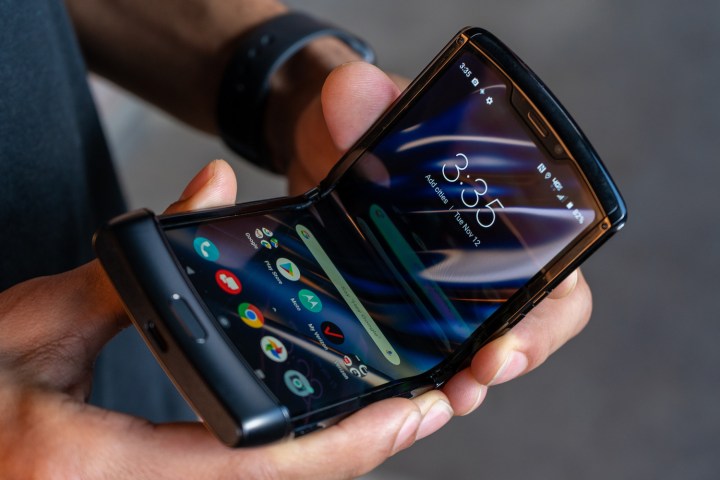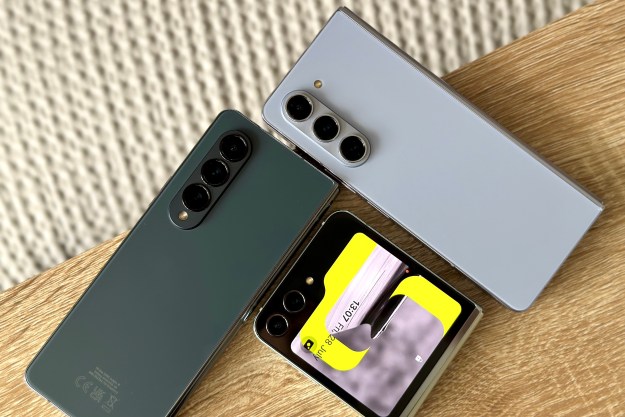Foldable phones are the future, but what will they look like? The Motorola Razr is Motorola’s answer to that question, and it’s a nostalgia-tickling stunner that brings the Razr V3’s iconic design to 2019. The horizontal fold is leagues apart from the Samsung Galaxy Fold, which uses a vertical fold to hide a massive tablet-sized screen. But which design is better, and which phone is the one to buy right now? We put the two folding phones head to head to find out.
Specs
| Motorola Razr | Samsung Galaxy Fold | |
| Size | Unfolded: 172 x 72 x 6.9 mm, folded: 94 x 72 x 14 mm | Unfolded: 160.9 x 117.9 x 7.5 mm, folded: 160.9 x 62.9 x 17 mm |
| Weight | 205 grams (7.2oz ounces) | 263 grams (9.28 ounces) |
| Screen size | 6.2-inch POLED and 2.7-inch GOLED | 7.3-inch Dynamic AMOLED and 4.6-inch Super AMOLED |
| Screen resolution | 2142 x 876 pixels and 800 x 600 pixels | 2152 x 1536 pixels and 1680 x 720 pixels |
| Operating system | Android 9.0 Pie | Android 9.0 Pie |
| Storage space | 128GB | 512GB |
| MicroSD card slot | No | No |
| Tap-to-pay services | Google Pay | Google Pay, Samsung Pay |
| Processor | Qualcomm Snapdragon 710 | Qualcomm Snapdragon 855 |
| RAM | 6GB | 12GB |
| Camera | 16-megapixel rear, 5-megapixel front | Triple-lens ultra-wide-angle 16-megapixel, standard 12MP with OIS and variable aperture, and telephoto 12MP with OIS rear, 10MP front closed, 10MP and 8MP front open |
| Video | Not confirmed yet | 2160p at 60 frames per second, 1080p at 240 fps, 720p at 960 fps |
| Bluetooth version | Bluetooth 5.0 | Bluetooth 5.0 |
| Ports | USB-C | USB-C |
| Fingerprint sensor | Yes | Yes (side) |
| Water resistance | Splash-resistant nano-coating | None |
| Battery | 2,150mAh
15W fast charging |
4,380mAh (4,325mAh 5G model)
Quick Charge 2.0 (18W) Qi wireless charging Wireless Powershare |
| App marketplace | Google Play Store | Google Play Store |
| Network support | Verizon | AT&T, T-Mobile |
| Colors | Noir Black | Cosmos Black, Space Silver, Martian Green, or Astro Blue |
| Price | $1,500 | $1,980 |
| Buy from | Motorola | Samsung, AT&T |
| Review score | Hands-on review | 3.5 out of 5 stars |
Performance, battery life, and charging

Samsung went all out for its first folding phone, cramming as much top hardware into the Galaxy Fold as it possibly could. There’s the powerful Snapdragon 855, a huge 12GB of RAM, and 512GB of storage. There’s no MicroSD card expansion slot, but it hardly seems necessary. Such specs would be overkill on normal smartphones, but with the Galaxy Fold’s enormous internal screen and large multitasking potential, this much hardware is required, and it keeps the Galaxy Fold’s performance smooth and snappy.
Motorola hasn’t used top specs in its flagships for a while now, and it’s not changing that with the Motorola Razr. Instead, you’ll find the midrange Snapdragon 710, 6GB of RAM, and 128GB of storage, with no MicroSD expansion. Those are good specs, but push it with the latest 3D games and you might see some slowdown. That 128GB of storage is fairly roomy, but for serious media-lovers or heavy gamers, the lack of additional space may hurt. Still, performance is good.
We haven’t had a chance to test the Razr’s battery, but we’re worried the 2,150mAh capacity will struggle to make it through the day. Most modern flagships use at least 3,000mAh, and such a small battery could spell disaster for Motorola’s foldable. The Galaxy Fold’s massive internal screen requires a much larger 4,380mAh battery to get a full day’s use. Only the Galaxy Fold has wireless charging, but both have similar levels of fast charging.
While there’s still a lot to be answered where the Razr’s performance and battery life is concerned, it’s clear the Galaxy Fold is the far more powerful of the two.
Winner: Samsung Galaxy Fold
Design and durability
- 1. Motorola Razr
- 2. Samsung Galaxy Fold
These two phones represent very different design philosophies for foldable phones. The Galaxy Fold embraces the big screen future, unfolding into a massive 7.3-inch display. There’s a sizable notch housing the selfie lenses in the top-right, but it’s otherwise almost entirely screen. That’s less so around the front, where the 4.6-inch display is surrounded by masses of bezel.
The Motorola Razr is — in a word — stunning. Motorola has borrowed heavily from the phone’s namesake, updating the original Motorola Razr V3‘s iconic style for a modern audience. The 6.2-inch internal screen is still large, but the emphasis here is on delivering a portable large screen, rather than a tablet that can be squeezed into a pocket. Motorola has used the foldable phone to make a 6.2-inch screen fit easily in a pocket, and it seems to have worked. There’s still a notch, but it’s small, and around the front, the 2.7-inch front display fits extremely well into the design.
Neither has water-resistance, and neither is likely to be all that durable either. Foldable phones are still new tech, and it’s likely to be some time before we see them become tough and rugged. The Razr’s steel frame gives it an edge though.
We’re giving this to the Razr for its desirable design.
Winner: Motorola Razr
Display

The Razr’s main display is a 6.2-inch plastic OLED running a 2142 x 876-pixel resolution. On the outside, you’ll find a 2.7-inch glass OLED display running an 800 x 600 resolution. They’re both excellent looking OLED displays, but the comparatively low resolution doesn’t hold up against the Galaxy Fold’s dual displays. The 4.6-inch Super AMOLED display on the front has a sharp 1680 x 720 resolution, but it’s the 7.3-inch Dynamic AMOLED display running a 2152 x 1536 pixel resolution that steals the show. Samsung is making some of the top displays around, and the Galaxy Fold is one of their best, with strong blacks and vibrant colors.
While the crease is a major downside, the Fold’s displays are still much stronger than the Razr’s.
Winner: Samsung Galaxy Fold
Camera

The Galaxy Fold is a big phone, and that means more room for camera lenses. Samsung’s folding phone rocks six camera lenses in total. The folded front houses a 10-megapixel lens, while unfolding reveals another 10-megapixel lens with a depth-sensing 8-megapixel lens. Around the back, there’s a 16-megapixel ultrawide lens, a 12-megapixel standard lens (with variable aperture), and a 12-megapixel telephoto lens. It’s a formidable setup, even if it’s not quite good enough to be one of the best camera phones.
It is, however, leagues ahead of the Razr’s camera. The Razr has a 16-megapixel main lens on the back of the phone, joined by a 5-megapixel front-facing lens. It’s unlikely the Razr will match the Fold’s camera, but it still has some tricks up its sleeve. You can take selfies with the main lens by using the outer display when folded, and when unfolded, the outer display can show timers and a preview of your finished shot.
But even with some nifty little tricks, there’s no chance the Razr can beat the Fold’s six lenses.
Winner: Samsung Galaxy Fold
Software and updates

Both phones run Android 9.0 Pie, but the Galaxy Fold conceals it under Samsung’s custom One UI skin. It’s a good skin, with some extras you won’t find in regular Android. The Razr uses close to stock Android, with a few Motorola additions. Your choice between the two is personal, but honestly, it won’t take long to get used to either.
Software update speed is more important, and Samsung is one of the slowest updaters in the business. Unfortunately, Motorola isn’t exactly quick either. Based on past performance, we expect Samsung may even beat Motorola to the punch in updating to Android 10.
It’s a tough category to score because we prefer Motorola’s slim Android build — but Samsung tends to update a touch faster. It’s a tie.
Winner: Tie
Special features

The Razr is loaded with all the usual Motorola special features, including the gesture-based Moto Actions. There are a few features tied specifically to the outer display, including the new camera features, and the ability to check your notifications, reply to messages, and more, using just the smaller outer display.
But the Galaxy Fold comes equipped with Samsung’s usual roster of special features, and it wins through pure numbers. There’s Wireless Powershare to charge other Qi-charging devices, Bixby, Samsung Health, Knox, and Health, among other special features. That’s without even mentioning the massive internal screen, which turns your phone into a tablet when required. It’s a slam dunk for the Galaxy Fold here.
Winner: Samsung Galaxy Fold
Price and availability
The Samsung Galaxy Fold is currently available from AT&T and T-Mobile, and unlocked from Samsung. It costs $1,980. The Motorola Razr will be available for pre-order from December 26, and will ship on January 9, 2020. It will start from $1,500 and will be available exclusively on Verizon.
Overall winner: Samsung Galaxy Fold
With stronger specs, a better-looking display, and a far better camera system, the Samsung Galaxy Fold is technically the winner of this contest. But there’s more to this contest than this comparison can put across. What are you looking to gain from a foldable phone? If you want a phone that doubles as a tablet, buy the Galaxy Fold. If the idea of shrinking a regular phone into a more pocketable package is more attractive, well, the Motorola Razr is the obvious choice.
But really, it’s probably for the best that you avoid both for now. Not only are they eye-wateringly expensive, but they’re also the first generation — which means the many bugs and issues haven’t been worked out yet. If you’re really sold, then, by all means, go for it, but if you’re still not sure, hold off and wait for the next generation of foldable phones to hit the market.
Editors' Recommendations
- Best Samsung Galaxy Z Fold 5 deals: discounts and trade-in credit
- Galaxy AI is coming to more Samsung phones very soon
- Best Samsung Galaxy Z Fold 4 deals: Grab the foldable phone for $700
- Best Samsung Galaxy Z Flip 5 deals: Get the foldable for free
- A surprise phone just beat the Galaxy S24 Ultra in a big way




